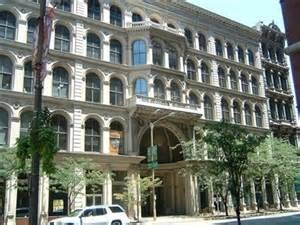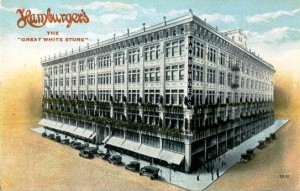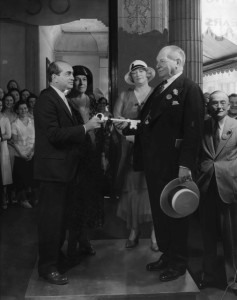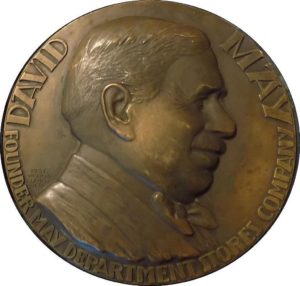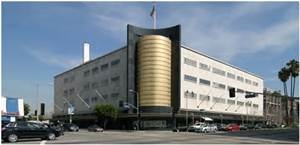David May
Value Codes I – H – E – L -P
Most people believe that the May Co. Department Stores began in St. Louis, since that city was its base for years. Few are aware that it started 10,000 feet in the air in a mining town in the Rocky Mountains west of Denver during a silver strike.
David May was born in Kaiserlautern, Bavaria (Germany) in 1848.
Along the way . . .
David May journeyed to the United States in 1864, at the age of 16.
His family arrived in New York and settled soon after in Cincinnati, Ohio, where David May stayed until graduating from business school.
In 1875, due to health issues, May moved to Leadville, Colorado, a silver mining boom city, with very “clean air.”
Two years later, in 1877, May opened a dry goods store with his business partner, Moses Shoenberg.
In 1887, David May bought a store in Denver, Colorado, entering into a partnership with Joseph and Louis Shoenberg, his brothers-in-law.
In 1888, May sold the Leadville, Colorado store to Meyers Harris.
The May Company
In 1892, May bought The Famous Clothing Store in St. Louis, Missouri.
In 1898, May purchased another store in Cleveland, Ohio.
He and his partners now called this business The May Company.
In 1905, May’s business headquarters moved to St. Louis,.
David May and his partners incorporated their growing number of stores as The May Department Stores Company in 1910.
In 1911, the incorporated company became publicly traded on the New York Stock Exchange.
Now the company could use “other peoples’ money” — stockholders investment money.
In 1911, May bought another St. Louis store, the William Bar Dry Goods Company, which he merged with The Famous Clothing Store. The new store was called Famous-Barr.
In 1912, May purchased the M. O’Neil Department Store in Akron, Ohio.
In 1923, May purchased Los Angeles department store, A. Hamburger & Sons. [click here]
He changed the name to May Company.
Between 1927 and 1977, the May Company organization acquired many stores.
Some stores had their names changed to May Company or derivatives of this name; others kept their names, but were run by the May Company under the leadership of the May family members.
Some of these stores include: Bernheim-Leader in Baltimore, Kaufmann’s in Pittsburgh, Pennsylvania, Daniels & Fisher Stores Company in Denver, Colorado, Hecht’s Stores in Baltimore, Maryland and Washington D.C., G. Fox & Co. Department Store in Hartford, Connecticut, and Meier & Frank in Portland, Oregon. [click here]
1939 was a successful year for the May Company, bringing in $100 million in sales, as well as the opening of the iconic May Co. on Wilshire Boulevard in Los Angeles.
Family
In 1880, David May married Rosa Shoenberg (b.1860), his partner’s sister, in Leadville, CO.
They lived at 203 W. 5th Street in Leadville.
They had three sons, Morton J. (b. 1881), Tom (b. 1883) and Wilbur (b. 1898), and a daughter, Florence (1903-1995).
Morton J. May succeeded his father in running the May Company business.
In 1957, his son, Morton D. May, became CEO of May Company and served as Chairman of the Board from 1967 to 1972.
Tom May’s son, David May II, also joined the family business.
David May II was a buyer of merchandise for the stores in 1933.
He served on the Board of Directors from 1937 to 1947.
Then, he left to pursue other business endeavors for a few years.
In 1956, David May II became vice president and was the CFO by 1958.
He worked for May Company until 1977, when he retired.
Community
In 1877, David May helped found the Hebrew Benevolent Association in Leadville.
May and his family were founding members of Temple Israel, Leadville’s first congregation. [click here]
May served as vice president of the Temple and was a member of the building committee.
He also supported the local Orthodox synagogue, Kneseth Israel.
In Denver, May was active in Temple Emanuel.
He helped found the National Jewish Hospital for Consumptives, a Denver hospital that opened in 1899 and treated tuberculosis victims from across the country. May was a board member of the NJH until his death.
Fraternal
David May was a member of the Leadville B’nai B’rith chapter, beginning in 1879.
Civic
In 1881, May was elected County Treasurer of Lake County. He served for two terms in the position.
He also served the community as Director of the Leadville Board of Trade.
David and Rosa May were members of the Standard Club.
Their daughter, Florence, was a benefactor and life trustee of the Museum of Modern Art in New York. She donated many works of art that she collected with her second husband, Samuel A. Marx.
David May died in 1927 in Charlevoix, Michigan.
Sources
- Walter Ehrlich, Zion in the Valley: The Jewish Community of St. Louis, Volume 1 (Columbia, Mo: University of Missouri Press, 1997).
- Jeanne Abrams, “David May, 1848-1924,” Immigrant Entrepreneurship: German-American Business Biographies, March 30, 2012, <http://www.immigrantentrepreneurship.org/entry.php?rec=99>
Samantha Silver is curator of this David May exhibit.
Shawn Larson’s note: I wanted to send this picture to you so you can add the picture to your collection on David May. I am trying to get a hold of the Family to see if they would be interested in buying it, if not I am thinking about auctioning it. It is a one of a kind 24″ bronze medallion made in the 1930’s. [No address given. Sent via Facebook]
Multi-Generational Jewish Department Stores of the West
Neiman-Marcus of Dallas, Texas
Hamburger’s Department Store of Los Angeles, California
Gump’s of San Francisco, California
Meier & Frank of Portland, Oregon
Auerbach’s of Salt Lake City, Utah

